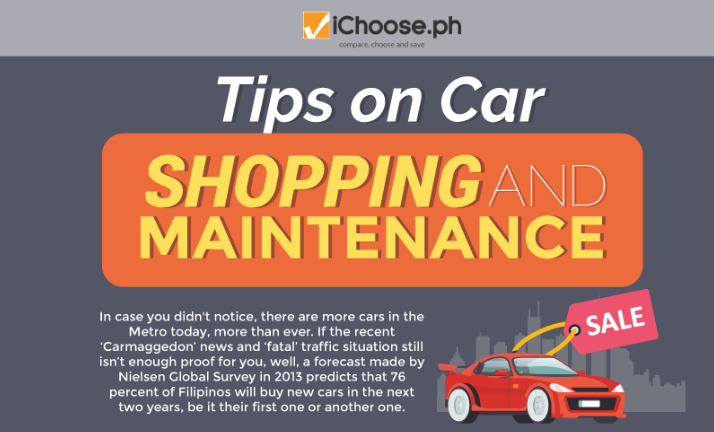Tips on Car Shopping and Maintenance [Infographic]
In case you didn’t notice, there are more cars in the Metro today, more than ever. If the recent ‘Carmaggedon’ news and ‘fatal’ traffic situation still isn’t enough proof for you, well, a forecast made by Nielsen Global Survey in 2013 predicts that 76 percent of Filipinos will buy new cars in the next two years, be it their first one or another one. This will make the Philippines one of the best markets for automotive in 2020.
This proves to be true, as the Chamber of Automotive Manufacturers of the Philippines Inc. (CAMPI), reports that in 2017, vehicle sales grew 16.7 percent in the first eight months of the year, and it will continue to grow bigger.
Since car shopping is a big decision to make, buyers should really do their research and weigh out their options before saying yes to a dealer. After all, there are many available options in the market today, making the decision a whole lot harder.
Having an idea of what you want—or need before you start making the rounds of dealerships can save both time and money. With so many brands and types of vehicles to choose from, consumers have more possibilities than ever, how can you shop for the best car deal out there? Here are some tips on car shopping you need to know now:
Do Your Research
They will not say knowledge is power without a valid reason. Many car experts will advise car shoppers that they should have a piece of clear background knowledge on the cars they are eyeing to buy. According to them, it is a mistake to arrive at a car lot without first researching. Thankfully, this task easier made than before: you can canvass your options and research about them without even leaving your seat.
There are a lot of online forums and websites that compare options down to the littlest specification, and most importantly, price. By researching the make, model, and style of the car, and reviewing insurance rates and financing, you should be able to put yourself in a car that you will enjoy for many years to come.
New or Old?
Buying a new or used vehicle each has its own pros and cons. Buying brand new models will give you convenience and ease, since there is a warranty, everything is on the tip-top shape, and no work needs to be done. However, it may come with a hefty price tag, which can be a deal-breaker for some.
Opting for used ones, on the other hand, can be a more tedious process: you have to check a lot of things and make sure you’re not buying scrap metal with wheels. If you are negotiating with a dealer or the previous owner, it is important to have—again, knowledge. You can research the recent resale prices for that specific car model. This data will give you major bargaining power.
Canvass and Shop Around
Never. Buy. The first car you see. It is an unwritten commandment that you should walk out of at least one dealership—just to weigh out other options. This way, you can always know their rock-bottom price. Dealerships price their vehicles differently depending upon their location and market. Buying a car on a whim is a risky endeavor. You might realize after it’s too late that you can’t afford the car, or you may find that the performance of the car just doesn’t meet your expectations.
Always Test Drive
Did you know that a whopping 90% of the people who buy a new car test drive it? You want to test drive the car for many reasons—ease of driving, run of the engine, but comfort should be foremost in your mind. If you have children, bring them along on the test drive. Their comfort level is important too, if not more important than yours.
Most importantly:
Buy a Car You Can Afford
If you are considering buying another car before your current vehicle is paid off, you need to seriously reassess whether or not you can really afford to buy another car. You don’t want to be saddled with an upside-down car loan.
Tips on Car Maintenance
New or old, all vehicles need regular maintenance to run efficiently. But how often should you change your oil? Or how do you know when your tires are ready to be replaced? Consider this your own cheat sheet:
Follow the manual
Car manuals exist for a reason: the makers of your car know it better than you. Though there are times that you may know better—after all, you are the one driving it, it is better to play on the safe side and don’t take the manual for granted. Most of the time, following what the manual says is one of the best ways to extend the life of your vehicle and may save you a lot on vehicle repairs.
While different cars may have different problems and symptoms, they may not necessarily have the same solutions. Check out the owner’s manual and know insider info on servicing the vehicle, oil change, how to know your fluids are the right color and levels, and the proper grade of fuel to use.
Check under the hood, regularly
The most important parts of your car are most in the bonnet. Fluids, belts, hoses, battery, keep an eye on them regularly. Your car depends on fluids to run effectively and most of these fluids have dipsticks so it’s quite easy to check the levels periodically. Check your oil levels so as to help protect and extend the life of your engine. Check your belts for wear and fraying on the belt edges.
Don’t scrimp on the replacements
Your car didn’t come cheap, neither does its maintenance costs. As much as possible, follow the recommended types and brands of oils or fluids that are meant for your car model and type. Opting for those cheaper options can either damage it more or make you spend twice the price in the long run.
Have a Go-To Mechanic
It will be best to have a well-recommended mechanic on standby. Don’t wait till you need a mechanic before you find one. Having a pro check on your car would pay off in the long run because minor problems would have been discovered before it escalates to a major one.
Keep your car clean
Keep your car clean by washing it regularly. Part of taking care of your vehicle is making sure that it is clean all the time, both on the inside and out.
Follow a maintenance schedule
Cars need regular maintenance and servicing whether something is broken or not. Having a well-defined and followed maintenance schedule should be one of your top priorities if you want to keep your car in good shape.
Keep servicing receipts
Most people throw away receipts after purchase. But, did you know that keeping service receipts for your car can increase resale value? It will also help you in keeping a better track of when and what services have to be done and follow your maintenance schedule. At the same time, receipts can act like contracts that will hold your mechanic liable if the same issue goes wrong with your car after you just got it fixed.
More useful reads from iChoose.ph







